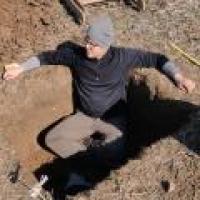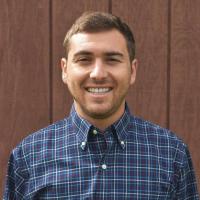Graduate Student Research Highlights
Graduate students in our department are conducting research on a wide range of topics across the sub-fields, below are just a few of the examples of such research of our current student and our recent alumni.

Benjamin Cross is a North American archaeologist that focuses on the prehistoric Native American groups along the Ohio and Mississippi River valleys. His current research focuses on understanding the resiliency of Fort Ancient communities to environmental changes, in particular flooding. These early agricultural communities would have had the benefits of the rich floodplain ecology and soils for their crops, but also would have had to deal with persistent threats from flooding. Cross uses multiple geoarchaeological methods to better understand dynamic socio-ecological relationships in the past, as well as help inform the decisions modern river towns make regarding how to plan for floods. He also has an interest in communicating archaeology to the public in a way that is both engaging and educational.

Evonne Turner-Byfield's research employs bioarchaeology to assess inequality, disease, and structural violence amongst marginalized populations in the Caribbean. Her current focus is on the pre- and post-colonial populations of Jamaica.

Madelyn Green is a biological anthropology PhD student who focuses on the biocultural feedback effects of prehistoric people. Madelyn is particularly interested in the impacts cultural technological developments have on the biological relationships between different prehistoric populations. Her dissertation research investigates the influence seafaring technology development and usage had on the scope and rate of human biological interactions and migrations throughout the East Asian coast and the surrounding islands. This focus is used to understand past and present human variation based on the interactions between biology and culture among human populations. Further, Madelyn seeks to apply her research to challenge nationalistic narratives that employ flawed models of human migration in the past to justify colonization and oppression of modern people.

Craig Shapiro is an archaeologist with interests in landscape archaeology and applied geospatial technologies. His research is focused on preliminary survey of a LiDAR dataset—digital imagery that results from airborne survey, and which reveals elevation changes in the ground surface. It reveals the Sāmoan Islands as an entirely human-modified environment, consisting of a system of ditches and terraces that extend from the coast to the remote interior. Shapiro examines how these ditches and terraces served as a mitigation system that drained saturated soils and controlled flooding in the past, which in turn supported local agricultural production and maintained the integrity of the island’s soils and ecosystem. His research also suggests that prehistoric Sāmoans not only knew how to target specific soils for agricultural production, but that they knew that they needed to place ditches in order to maximize the agricultural output of an area.

Harold (Butch) Wright's research interests include the cultural-environmental adaptations of Indigenous groups. Specifically, he works with Indigenous groups living in the Amazon Basin of Brazil, where he studies their subsistence strategies. For his dissertation work, Butch studied the population of Parque das Tribos, a multiethnic, predominantly Indigenous, unincorporated community located on the periphery of the city of Manaus, the largest city in the Amazon. Established in 2014, the community is currently home to 746 families of 35 distinct ethnic groups. For his research, Butch spent six months in Brazil in 2022 conducting ethnographic research and semi-structured interviews to understand the subsistence strategies of the local population, including consumption, means of access, and food exchanges. Butch's research questions include the following:
- Are standardized food security measures suitable for use among the population of the community?
- What are the means of access that the local population utilizes to obtain food?
- Are social networks in the community used as coping mechanisms or as long-term subsistence strategies?
External Awards
- Fulbright Hays Doctoral Dissertation Research Abroad Fellowship (FH-DDRA), US Department of Education (Research)
- Foreign Language and Area Studies (FLAS) Fellowship, Center for Latin American Studies, The Ohio State University (Advanced Portuguese)
Internal Grant
- Daniel Hughes Memorial Fund Grant, Department of Anthropology, The Ohio State University (Academic)
- DEM3 Anthropology Research and Development Fund Grant, Department of Anthropology, The Ohio State University (Academic)
- Tinker Foundation Field Research Grant, the Ohio State University
- Social and Behavioral Sciences Graduate Fellowship, Department of Anthropology, The Ohio State University

Steven Rhue is a PhD candidate in the Department of Anthropology and research associate in the Human Biological Anthropology Laboratory (HBAL). As a medical anthropologist and ethnographer, Steven’s work documents the impact of resource insecurity on human health and wellbeing. In particular, he is concerned with the inclusion of children’s voices in both research and policy concerning household water insecurity. His doctoral project, funded by the National Science Foundation (BCS-2215227), explores how children experience and perceive their wellbeing to be impacted by insufficient/unsafe water in the urban Amazon of Brazil. Steven’s dissertation is guided by 3 overarching questions.
- What are children’s roles and responsibilities related to the use, consumption, and management of water within the home?
- What activates do children engage in to address situations of insufficient or unsafe water for themselves and/or others in the home?
- How do children, in their own words, perceive their emotional well-being to be impacted by their roles, responsibilities, and coping strategies related to water for the home?
Steven is also first author on a publication in WIREs Water, “The effects of household water insecurity on child health and well-being” , the first academic review to synthesize the literature on children’s water insecurity. In addition to his academic responsibilities, Steven is a contributor in residence for Synapsis: A Health Humanities Journal, published by Columbia University, where he regularly authors public scholarship connecting medicine and the humanities.
External Awards
- National Science Foundation Cultural Anthropology Program - Doctoral Dissertation Research Improvement Grant
- Tinker Foundation – Field Research Grant
Internal Awards
- Office of International Affairs – International Research and Scholar Grant
- Global Arts+ Humanities Society of Fellows – Small Grant for Cross-Disciplinary Graduate Research
- Mershon Center for International Security Studies – Student Research Grant
- Department of Anthropology – DEM3 Anthropology and Development Fund
- Department of Anthropology – Daniel T. Hughes Memorial Fund
- Department of Anthropology – Larsen Research and Travel Award
- Department of Anthropology – Most Creative Work in Anthropology
